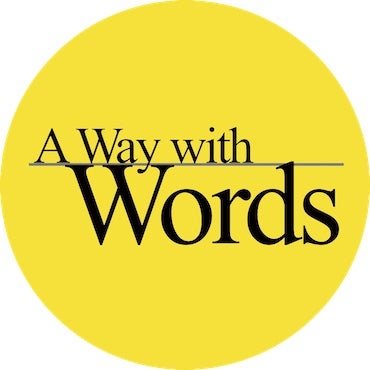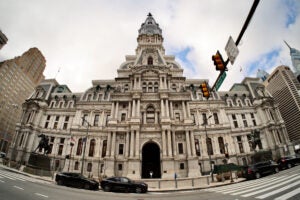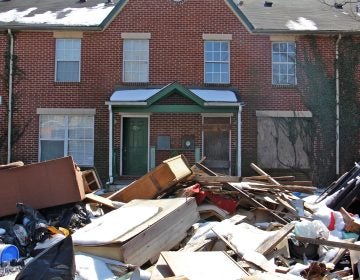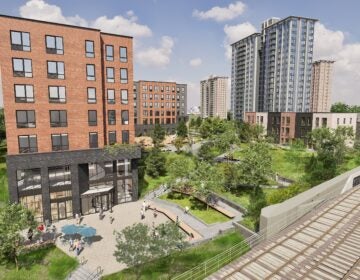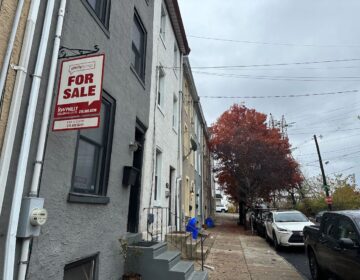Neighbors want to see Philly’s Logan Triangle redeveloped. Will it ever happen?
The city posted a new request for proposal in October but decided not to select a developer for the infamous site.
Listen 4:16
North Philadelphia’s Logan Triangle once held about 1,000 homes that were demolished in the 1980s. (Kimberly Paynter/WHYY)
Have a question about Philly’s neighborhoods or the systems that shape them? PlanPhilly reporters want to hear from you! Ask us a question or send us a story idea you think we should cover.
Sonia Garrett thinks about the Logan Triangle every day. She can’t help it.
“It’s something that could never be ignored. It is a blight. It is a discouragement to the neighborhood,” said Garrett, a longtime resident, on a recent weekday afternoon.
The retiree lives two blocks from the triangle, an infamous 35-acre slice of Northwest Philadelphia that’s sat vacant since the city took the extraordinary step of demolishing hundreds of rowhouses because they were sinking into the unstable soil beneath them.
Garrett mostly keeps an eye on quality-of-life issues, like how tall the grass is growing and whether she finds any drug paraphernalia or evidence of dumping. But she also mulls the impact of the triangle being redeveloped — how much that would mean to her “forgotten” corner of the city.
“I can’t put the blame on anyone. I just want to see something happen at the site,” said Garrett.
More than two decades after the last family left the triangle, there’s no timetable for when that might happen.
Earlier this month, the city quietly halted its latest effort to sell the sprawling site. The setback is the latest in a string of stumbling blocks that have seemingly relegated the land to a state of perpetual limbo. Despite several planning studies, countless community meetings and at least four development proposals, the city appears no closer to putting the triangle into productive use.
It’s unclear what may have derailed things this time around. But the prospect of redeveloping the Logan Triangle has never been easy. As it stands today, only about half of the site is suitable for redevelopment. That means any interested developer would likely need to remediate the land before starting construction — to keep any new structures from sinking like the homes that once occupied the triangle.
“It’s very hard to develop projects, let alone develop projects that are heavy when it comes to soil contamination and soil issues,” said developer Mohamed “Mo” Rushdy, president of the Building Industry Association of Philadelphia.
The Philadelphia Redevelopment Authority, which owns the land, received just one response to the request for proposal it posted last October. And the city decided not to select that developer. A city spokesperson declined to discuss why.
The applicant, Gilbane Development Company, is a global outfit with a focus on projects with social impact. A spokesperson declined to provide details about the company’s proposal for the triangle, saying in a statement that it “respects the PRA’s decision and looks forward to future opportunities that may be issued.”
The city issued a new RFP after the Goldenberg Group walked away from its plans to build a recreation center with a library and a computer lab. Neighbors say members of the development team told residents the company had struggled to secure enough funding, ending a nearly decade-long effort to breathe new life into the triangle.
The homes that once populated the Logan Triangle were built in the 1920s on top of a creek bed filled with ash and cinder. A century later, that unsteady mixture remains and must be removed and replaced by any developer interested in building on the site.
For a parcel the size of 20 city blocks, the work would add millions to any project budget at a time when the cost of construction remains high.
A big cost associated with this type of remediation is paying to dispose of all the problematic soil, a task that could require hundreds of truckloads of dirt to be taken to a regulated facility if environmental tests show the material is contaminated beyond state standards.
“If you don’t have a budget for handling the dirt, then maybe you haven’t thought through the whole process yet,” said James Manuel, a senior project manager for React Environmental Professional Services Group.
For now, the city is not providing any public funding to help cover the up-front cost, requiring any development company to line up those dollars on its own. To Rushdy, that makes redeveloping the Logan Triangle “cost-prohibitive.”
For a project with 500 units of housing, remediation would cost up to $30 million, he said.
“Unless you’re getting that kind of money from some up-front subsidies that are attached to that RFP, or actually a separate RFP, to clean it up, you know, and getting funding from the feds, I just don’t see much happening there in terms of development,” said Rushdy.
Garrett knows many of her neighbors feel the same way — that they’ve given up on the idea of the Logan Triangle ever being anything more than a collection of grassy lots near Roosevelt Boulevard.
She’s not there yet, though. In her mind, the site has too much potential to be a lost cause. She’d love to see the site used for senior housing and a community center, as well as walking paths and a dog park.
She gets emotional when she starts thinking about the day when the triangle is transformed.
“Hope is not dead,” said Garrett.
 This story is a part of Every Voice, Every Vote, a collaborative project managed by The Lenfest Institute for Journalism. The William Penn Foundation provides lead support for Every Voice, Every Vote in 2024 and 2025 with additional funding from The Lenfest Institute for Journalism, Comcast NBC Universal, The John S. and James L. Knight Foundation, Henry L. Kimelman Family Foundation, Judy and Peter Leone, Arctos Foundation, Wyncote Foundation, 25th Century Foundation, and Dolfinger-McMahon Foundation.
This story is a part of Every Voice, Every Vote, a collaborative project managed by The Lenfest Institute for Journalism. The William Penn Foundation provides lead support for Every Voice, Every Vote in 2024 and 2025 with additional funding from The Lenfest Institute for Journalism, Comcast NBC Universal, The John S. and James L. Knight Foundation, Henry L. Kimelman Family Foundation, Judy and Peter Leone, Arctos Foundation, Wyncote Foundation, 25th Century Foundation, and Dolfinger-McMahon Foundation.
To learn more about the project and view a full list of supporters, visit www.everyvoice-everyvote.org. Editorial content is created independently of the project’s donors.
WHYY is your source for fact-based, in-depth journalism and information. As a nonprofit organization, we rely on financial support from readers like you. Please give today.
